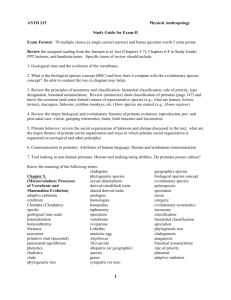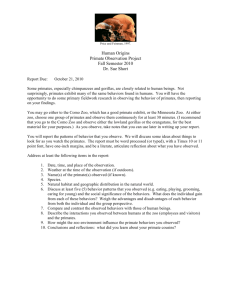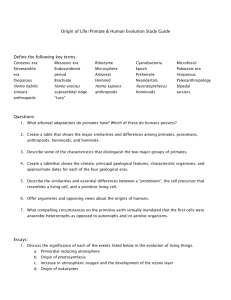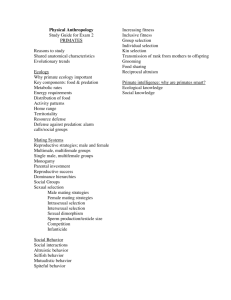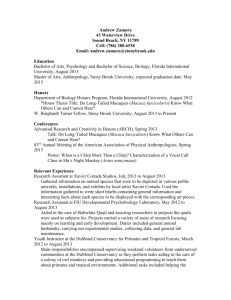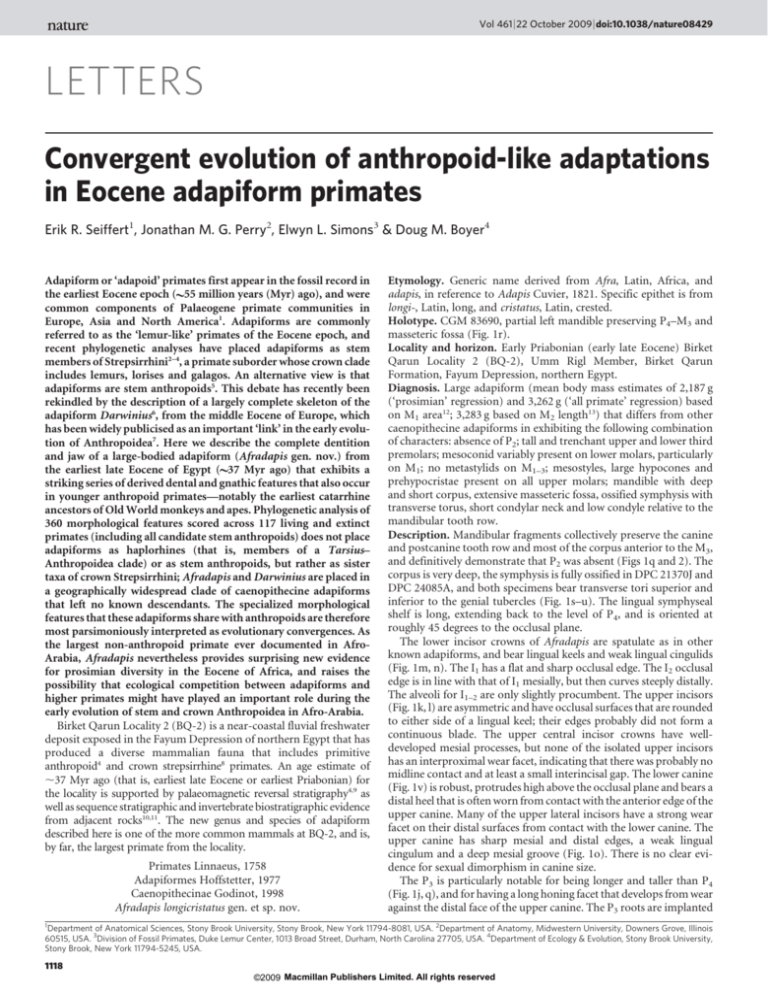
Vol 461 | 22 October 2009 | doi:10.1038/nature08429
LETTERS
Convergent evolution of anthropoid-like adaptations
in Eocene adapiform primates
Erik R. Seiffert1, Jonathan M. G. Perry2, Elwyn L. Simons3 & Doug M. Boyer4
Adapiform or ‘adapoid’ primates first appear in the fossil record in
the earliest Eocene epoch ( 55 million years (Myr) ago), and were
common components of Palaeogene primate communities in
Europe, Asia and North America1. Adapiforms are commonly
referred to as the ‘lemur-like’ primates of the Eocene epoch, and
recent phylogenetic analyses have placed adapiforms as stem
members of Strepsirrhini2–4, a primate suborder whose crown clade
includes lemurs, lorises and galagos. An alternative view is that
adapiforms are stem anthropoids5. This debate has recently been
rekindled by the description of a largely complete skeleton of the
adapiform Darwinius6, from the middle Eocene of Europe, which
has been widely publicised as an important ‘link’ in the early evolution of Anthropoidea7. Here we describe the complete dentition
and jaw of a large-bodied adapiform (Afradapis gen. nov.) from
the earliest late Eocene of Egypt ( 37 Myr ago) that exhibits a
striking series of derived dental and gnathic features that also occur
in younger anthropoid primates—notably the earliest catarrhine
ancestors of Old World monkeys and apes. Phylogenetic analysis of
360 morphological features scored across 117 living and extinct
primates (including all candidate stem anthropoids) does not place
adapiforms as haplorhines (that is, members of a Tarsius–
Anthropoidea clade) or as stem anthropoids, but rather as sister
taxa of crown Strepsirrhini; Afradapis and Darwinius are placed in
a geographically widespread clade of caenopithecine adapiforms
that left no known descendants. The specialized morphological
features that these adapiforms share with anthropoids are therefore
most parsimoniously interpreted as evolutionary convergences. As
the largest non-anthropoid primate ever documented in AfroArabia, Afradapis nevertheless provides surprising new evidence
for prosimian diversity in the Eocene of Africa, and raises the
possibility that ecological competition between adapiforms and
higher primates might have played an important role during the
early evolution of stem and crown Anthropoidea in Afro-Arabia.
Birket Qarun Locality 2 (BQ-2) is a near-coastal fluvial freshwater
deposit exposed in the Fayum Depression of northern Egypt that has
produced a diverse mammalian fauna that includes primitive
anthropoid4 and crown strepsirrhine8 primates. An age estimate of
,37 Myr ago (that is, earliest late Eocene or earliest Priabonian) for
the locality is supported by palaeomagnetic reversal stratigraphy4,9 as
well as sequence stratigraphic and invertebrate biostratigraphic evidence
from adjacent rocks10,11. The new genus and species of adapiform
described here is one of the more common mammals at BQ-2, and is,
by far, the largest primate from the locality.
Primates Linnaeus, 1758
Adapiformes Hoffstetter, 1977
Caenopithecinae Godinot, 1998
Afradapis longicristatus gen. et sp. nov.
Etymology. Generic name derived from Afra, Latin, Africa, and
adapis, in reference to Adapis Cuvier, 1821. Specific epithet is from
longi-, Latin, long, and cristatus, Latin, crested.
Holotype. CGM 83690, partial left mandible preserving P4–M3 and
masseteric fossa (Fig. 1r).
Locality and horizon. Early Priabonian (early late Eocene) Birket
Qarun Locality 2 (BQ-2), Umm Rigl Member, Birket Qarun
Formation, Fayum Depression, northern Egypt.
Diagnosis. Large adapiform (mean body mass estimates of 2,187 g
(‘prosimian’ regression) and 3,262 g (‘all primate’ regression) based
on M1 area12; 3,283 g based on M2 length13) that differs from other
caenopithecine adapiforms in exhibiting the following combination
of characters: absence of P2; tall and trenchant upper and lower third
premolars; mesoconid variably present on lower molars, particularly
on M1; no metastylids on M1–3; mesostyles, large hypocones and
prehypocristae present on all upper molars; mandible with deep
and short corpus, extensive masseteric fossa, ossified symphysis with
transverse torus, short condylar neck and low condyle relative to the
mandibular tooth row.
Description. Mandibular fragments collectively preserve the canine
and postcanine tooth row and most of the corpus anterior to the M3,
and definitively demonstrate that P2 was absent (Figs 1q and 2). The
corpus is very deep, the symphysis is fully ossified in DPC 21370J and
DPC 24085A, and both specimens bear transverse tori superior and
inferior to the genial tubercles (Fig. 1s–u). The lingual symphyseal
shelf is long, extending back to the level of P4, and is oriented at
roughly 45 degrees to the occlusal plane.
The lower incisor crowns of Afradapis are spatulate as in other
known adapiforms, and bear lingual keels and weak lingual cingulids
(Fig. 1m, n). The I1 has a flat and sharp occlusal edge. The I2 occlusal
edge is in line with that of I1 mesially, but then curves steeply distally.
The alveoli for I1–2 are only slightly procumbent. The upper incisors
(Fig. 1k, l) are asymmetric and have occlusal surfaces that are rounded
to either side of a lingual keel; their edges probably did not form a
continuous blade. The upper central incisor crowns have welldeveloped mesial processes, but none of the isolated upper incisors
has an interproximal wear facet, indicating that there was probably no
midline contact and at least a small interincisal gap. The lower canine
(Fig. 1v) is robust, protrudes high above the occlusal plane and bears a
distal heel that is often worn from contact with the anterior edge of the
upper canine. Many of the upper lateral incisors have a strong wear
facet on their distal surfaces from contact with the lower canine. The
upper canine has sharp mesial and distal edges, a weak lingual
cingulum and a deep mesial groove (Fig. 1o). There is no clear evidence for sexual dimorphism in canine size.
The P3 is particularly notable for being longer and taller than P4
(Fig. 1j, q), and for having a long honing facet that develops from wear
against the distal face of the upper canine. The P3 roots are implanted
1
Department of Anatomical Sciences, Stony Brook University, Stony Brook, New York 11794-8081, USA. 2Department of Anatomy, Midwestern University, Downers Grove, Illinois
60515, USA. 3Division of Fossil Primates, Duke Lemur Center, 1013 Broad Street, Durham, North Carolina 27705, USA. 4Department of Ecology & Evolution, Stony Brook University,
Stony Brook, New York 11794-5245, USA.
1118
©2009 Macmillan Publishers Limited. All rights reserved
LETTERS
NATURE | Vol 461 | 22 October 2009
k
b
a
c
d
l
l1
5 mm
e
l2
l1
n
m
l2
g
f
M3
M2
h
i
M1
j
P4
p
P4
P3
M1
M2
M3
mg
o
q
r
1 cm
stt
s
t
u
gf
1 cm
v
itt
Figure 1 | Dental and mandibular remains of Afradapis longicristatus gen. et
sp. nov. a, M3 (DPC 21458D); b, M2 (DPC 21370B); c, M1 (DPC 21366A);
d, P4 (DPC 21370C); e, P3 (DPC 21500G); f, M3 (DPC 21366F, reversed); g, M2
(DPC 21366E); h, M1 (DPC 21456C); i, P4 (DPC 21548I); j, P3 (DPC 21500I,
reversed); k, I2 (DPC 22440D; incisors are mirror-imaged to reconstruct
incisor battery); l, I1 (DPC 22442K); m, I2 (DPC 21456G); n, I1 (DPC 21639E);
o, upper canine (DPC 21578J) in oblique buccal view; p, mandible with M2–3
(DPC 23275); q, mandible with P3–M1 and lower canine alveolus (DPC
21458F); r, holotype lower mandible with P4–M3 (CGM 83690); s–u, microCT reconstruction of edentulous mandible preserving fused symphysis and
transverse tori (DPC 21370J) in oblique posterior (s, t) and medial (u) views
(specimen is digitally sliced along the midline of the symphysis in t and
u); v, lower canine (DPC 21365E) in buccal view. Five millimetre scale bar is
for a–o and v; upper 1 cm scale bar is for p–r; lower 1 cm scale bar is for s–u. gf,
Genial fossa; i, incisor; itt, inferior transverse torus; m, molar; mg, mesial
groove; p, premolar; stt, superior transverse torus.
obliquely with respect to those of P4, and the long axes of the primary
crests are strongly oblique with respect to the long axis of the tooth
row. Among primates, this derived complex of features, along with the
loss of P2, is otherwise seen only in living and extinct catarrhine
anthropoids, and is first documented among stem catarrhines three
million years later in the Fayum area14. Other caenopithecines retain a
small, single-rooted P2 (refs 6, 15–18). The P4 (Fig. 1i, q, r) has a
prominent, distolingually placed metaconid and a large talonid with
a distinct cristid obliqua. Only P3 and P4 of Afradapis have been
recovered as isolated teeth, consistent with P2 being absent. The P3
(Fig. 1e) has a tall, blade-like paracone and a very small protocone. The
P4 (Fig. 1d) is slightly waisted and has a relatively well-developed
protocone.
The upper and lower molars of Afradapis are superficially similar to
those of some highly folivorous extant primates, such as those of platyrrhine howler monkeys (Alouatta) and lemuriform indriids such as the
sifaka (Propithecus) and indri (Indri). Afradapis’ elaborate shearing
crests indicate that the species was likely to have been highly folivorous
as well. The lower molars of Afradapis (Fig. 1f–h) lack paraconids, but
otherwise have high cusps and long crests, and are often densely
crenulated. Lower molar length increases, and the relative length of
the trigonid basins decreases, distally along the toothrow. The hypoconulid is very small or absent on M1–2, but the M3 has a large hypoconulid lobe. The upper molars (Fig. 1a–c) have moderately tall cusps
and long, sharp crests. M1–2 have well-developed mesostyles, distinct
buccal cingula, large hypocones (derived from the posterior cingulum),
and trenchant postprotocristae and prehypocristae. A large paraconule
is present along the preprotocrista, but there is no metaconule. Upper
molars decrease in size, and have more rounded distal margins, moving
Figure 2 | Reconstruction of the mandible and lower dentition of Afradapis
longicristatus, gen. et sp. nov. Reconstruction is based on combined
information from specimens CGM 83690, DPC 23275, DPC 21458F and
DPC 21370J.
1119
©2009 Macmillan Publishers Limited. All rights reserved
LETTERS
NATURE | Vol 461 | 22 October 2009
70
81
99
69
74
Tupaia spp.
Plesiadapis tricuspidens
Plesiolestes problematicus
Altanius orlovi
Purgatorius unio
Stem and crown Anthropoidea (42 taxa)
Tarsius + omomyiforms (27 taxa)
Donrussellia provincialis
Donrussellia gallica
Panobius russelli
Galagidae (6 taxa)
Lorisidae (5 taxa)
Karanisia clarki
Lemuriformes (6 taxa)
Djebelemur martinezi
‘Anchomomys’ milleri
Anchomomys gaillardi
Asiadapis cambayensis
Marcgodinotius indicus
Rencunius zhoui
Wailekia orientale
Hoanghonius stehlini
Barnesia hauboldi
Protoadapis curvicuspidens
Cantius abditus
Pronycticebus gaudryi
Microadapis sciureus
Adapis parisiensis
Leptadapis magnus
Europolemur klatti
Godinotia neglecta
Mahgarita stevensi
Darwinius masillae
Aframonius dieides
Afradapis longicristatus
Caenopithecus lemuroides
Stem and crown Strepsirrhini
distally along the toothrow. The M3 bears an expanded talon and a
strongly convex distal margin, and has relatively small metacone, hypocone and paraconule cusps.
It has long been known that some adapiform lineages evolved
derived morphological features that are also seen in living and extinct
anthropoids (for example, fused mandibular symphyses, upper
canines with mesial grooves, enlarged and spatulate upper and lower
incisors, short and tall rostra)16. The phylogenetic significance of
these features has been a source of ongoing debate for decades3,5,19,20.
Of all known fossil prosimians (including Darwinius), Afradapis
provides perhaps the most detailed examples of derived anthropoidlike adaptations in its dental and mandibular morphology. As is
the case for many of the morphological features that some have
argued link adapiforms to anthropoids, however, the anthropoid-like
features of Afradapis (fused mandibular symphysis with transverse
torus, deep mandibular corpus, deep masseteric fossa, large upper
molar hypocones, absence of P2/2 and presence of an enlarged P3 with
a honing facet for the upper canine) are not present in the most
primitive undoubted fossil anthropoids, such as Biretia4 and
Proteopithecus21, indicating that the features are likely to have been
acquired through convergent evolution.
Despite the key role that adapiforms have had in debates surrounding anthropoid and strepsirrhine origins, the group has been poorly
sampled in recent analyses of primate interrelationships. We
expanded on previous analyses4,22 by scoring 117 living and extinct
primates (including 24 adapiforms, eight of which were not sampled
previously) for 360 morphological features and analysed the resulting
data set using the heuristic search algorithm in PAUP* 4.0b10 (ref. 23).
Parsimony analysis places Afradapis and its caenopithecine relatives,
including Darwinius, within a large clade of adapiform primates
that includes European adapines and ‘cercamoniines’ and North
American notharctines. This group, along with Asian sivaladapids
and asiadapines24, is recovered as one of several sister clades of crown
Strepsirrhini (Fig. 3; for methods see Methods; for character support,
see Supplementary Information). Interestingly, Afradapis and the
younger (,34 Myr ago) African caenopithecine Aframonius are
placed as consecutive sister taxa of European middle Eocene
Caenopithecus, indicating at least one dispersal across the Tethys
Sea. Given that there is no other compelling evidence for mammalian
faunal exchange between Europe and Afro-Arabia during the middle
Eocene25,26, it is possible that the few derived dental features that
Afradapis and Caenopithecus share to the exclusion of Aframonius
evolved independently on the two landmasses from more generalized
caenopithecine ancestors. More complete fossil evidence from the
middle Eocene of Europe and Afro-Arabia will be required to provide
a robust test of these alternative hypotheses.
The Darwinius holotype presents unique problems for phylogenetic
analysis because the specimen is a juvenile, most of its bones are
crushed or distorted, and many of the characters that have had a
key role in primate phylogenetics (that is, features of the dentition,
auditory region and ankle) cannot be evaluated. For instance, in our
opinion the orientation of the fibular facet on the astragalus cannot be
determined with confidence (contra ref. 6) because the astragalus is
damaged, the orientation of the trochlear surface cannot be determined, and the fibular facet is almost entirely obscured by the fibular
malleolus (see Fig. 11 in ref. 6). However, the topology presented in
Fig. 3 does not change if Darwinius is scored as having a straight-sided
fibular facet like haplorhines (and unlike all other adapiforms for
which this region is known). Constraining caenopithecine adapiforms
to be placed closer to crown Anthropoidea than two other groups
(Eosimiidae and Amphipithecidae from the Paleogene of Asia27–29)
that emerge as stem anthropoids in the unconstrained tree adds 12
steps to tree length (see Supplementary Information). Even in this
much longer tree, Darwinius and other caenopithecines are most
parsimoniously placed in a clade with more primitive adapiforms
such as adapines, asiadapines and ‘cercamoniines’, and not as intermediate forms that might link these taxa to undoubted anthropoids.
Figure 3 | Phylogenetic position of the adapiforms Afradapis and Darwinius
within Primates. Single tree recovered from parsimony analysis of a
morphological character matrix containing 360 characters scored across 117
taxa. Tree length 5 2,265.671; consistency index excluding uninformative
characters 5 0.1891; retention index 5 0.5848; rescaled consistency
index 5 0.1120. Values above branches are bootstrap support, based on
1,000 pseudoreplicates. See Supplementary Information for full tree, matrix,
methods and tests of alternative topologies.
The adapiform radiation produced an impressive range of morphologically diverse taxa whose evolutionary history is well documented in North America, Europe and, to a lesser extent, Asia.
Adapiforms were not definitively known from Africa until the last
decade, but it now seems that members of the group were not only
present in Afro-Arabia, but were probably common and quite
successful living alongside, and competing with, early anthropoid
primates in the middle and late Eocene. Our analysis shows that
adapiforms are unlikely to have given rise to Anthropoidea, but the
former were evidently the first primates to invade and occupy
anthropoid-like feeding niches in Africa. As early ecological competitors of stem and crown anthropoids, adapiforms may still have an
important role for understanding the selection pressures that drove
the origin and early evolution of Anthropoidea.
METHODS SUMMARY
The morphological character matrix analysed in this study is a modified version
of the matrix compiled and analysed in ref. 4. The results presented in Fig. 3 are
based on parsimony analysis of the matrix with some multistate characters
treated as ordered, and with ordered characters scaled, so that any single change
within a character could only contribute a maximum of one step to tree length.
For many characters, taxa exhibiting intraspecific variation were assigned an
intermediate character state, rather than a traditional polymorphic (for example,
‘0/1’) coding. Some characters documenting differences in premolar number
were constrained by step matrices that did not allow premolar teeth to be reacquired following an earlier loss. A molecular scaffold was implemented based
on the results of molecular studies, particularly analysis of short interspersed
elements (SINEs), that strongly support the monophyly of Malagasy lemuriforms, and, within Lorisiformes, a monophyletic Lorisidae and an Arctocebus–
Perodicticus clade30. The matrix was analysed with random addition sequence
and TBR branch swapping across 2,000 replicates. Tree lengths were recalculated
1120
©2009 Macmillan Publishers Limited. All rights reserved
LETTERS
NATURE | Vol 461 | 22 October 2009
after networks were re-rooted with Tupaia spp. Bootstrap support derives from
1,000 pseudoreplicates.
Full Methods and any associated references are available in the online version of
the paper at www.nature.com/nature.
Received 11 July; accepted 18 August 2009.
1.
2.
3.
4.
5.
6.
7.
8.
9.
10.
11.
12.
13.
14.
15.
16.
17.
18.
19.
20.
Godinot, M. A summary of adapiform systematics and phylogeny. Folia Primatol.
(Basel) 69 (suppl. 1), 218–249 (1998).
Marivaux, L. et al. Anthropoid primates from the Oligocene of Pakistan (Bugti
Hills): data on early anthropoid evolution and biogeography. Proc. Natl Acad. Sci.
USA 102, 8436–8441 (2005).
Ross, C., Williams, B. & Kay, R. F. Phylogenetic analysis of anthropoid
relationships. J. Hum. Evol. 35, 221–306 (1998).
Seiffert, E. R. et al. Basal anthropoids from Egypt and the antiquity of Africa’s
higher primate radiation. Science 310, 300–304 (2005).
Rasmussen, D. T. in Anthropoid Origins (eds Fleagle, J. G. & Kay, R. F.) 335–360
(Plenum, 1994).
Franzen, J. L. et al. Complete primate skeleton from the middle Eocene of Messel
in Germany: morphology and paleobiology. PLoS ONE 4, e5723 (2009).
Tudge, C. The Link: Uncovering Our Earliest Ancestor (Little, Brown & Company,
2009).
Seiffert, E. R., Simons, E. L. & Attia, Y. Fossil evidence for an ancient divergence of
lorises and galagos. Nature 422, 421–424 (2003).
Seiffert, E. R. Revised age estimates for the later Paleogene mammal faunas of
Egypt and Oman. Proc. Natl Acad. Sci. USA 103, 5000–5005 (2006).
Gingerich, P. D. Marine mammals (Cetacea and Sirenia) from the Eocene of Gebel
Mokattam and Fayum, Egypt: stratigraphy, age, and paleoenvironments. Univ.
Mich. Pap. Paleont. 30, 1–84 (1992).
Seiffert, E. R., Bown, T. M., Clyde, W. C. & Simons, E. L. in Elwyn L. Simons: A Search
for Origins (eds Fleagle, J. G. & Gilbert, C. C.) 71–86 (Springer, 2008).
Conroy, G. C. Problems of body-weight estimation in fossil primates. Int. J.
Primatol. 8, 115–137 (1987).
Kay, R. F. & Simons, E. L. The ecology of Oligocene African Anthropoidea. Int. J.
Primatol. 1, 21–37 (1980).
Simons, E. L. Discovery of the oldest known anthropoidean skull from the
Paleogene of Egypt. Science 247, 1567–1569 (1990).
Simons, E. L., Rasmussen, D. T. & Gingerich, P. D. New cercamoniine adapid from
Fayum, Egypt. J. Hum. Evol. 29, 577–589 (1995).
Rasmussen, D. T. The phylogenetic position of Mahgarita stevensi:
protoanthropoid or lemuroid? Int. J. Primatol. 11, 439–469 (1990).
Wilson, J. A. & Szalay, F. S. New adapid primate of European affinities from Texas.
Folia Primatol. (Basel) 25, 294–312 (1976).
Stehlin, H. G. Die Säugetiere des schweizerischen Eocaens. Abh. Schweiz. Paläont.
Ges. 41, 1299–1552 (1916).
Ross, C. F. in Anthropoid Origins (eds Fleagle, J. G. & Kay, R. F.) 469–548 (Plenum,
1994).
Simons, E. L. & Rasmussen, D. T. Skull of Catopithecus browni, an early Tertiary
catarrhine. Am. J. Phys. Anthropol. 100, 261–292 (1996).
21. Miller, E. R. & Simons, E. L. Dentition of Proteopithecus sylviae, an archaic
anthropoid from the Fayum, Egypt. Proc. Natl Acad. Sci. USA 94, 13760–13764
(1997).
22. Seiffert, E. R., Simons, E. L., Ryan, T. M. & Attia, Y. Additional remains of Wadilemur
elegans, a primitive stem galagid from the late Eocene of Egypt. Proc. Natl Acad. Sci.
USA 102, 11396–11401 (2005).
23. Swofford, D. L. PAUP* Phylogenetic Analysis Using Parsimony (*and Other
Methods), Version 4 (Sinauer Associates, 1998).
24. Rose, K. D. et al. Early Eocene Primates from Gujarat, India. J. Hum. Evol. 56,
366–404 (2009).
25. Gheerbrant, E. & Rage, J. C. Paleobiogeography of Africa: How distinct from
Gondwana and Laurasia? Palaeogeogr. Palaeoclimatol. Palaeoecol. 241, 224–246
(2006).
26. Tabuce, R. & Marivaux, L. Mammalian interchanges between Africa and Eurasia:
an analysis of temporal constraints on plausible anthropoid dispersals during the
Paleogene. Anthropol. Sci. 113, 27–32 (2005).
27. Chaimanee, Y., Suteethorn, V., Jaeger, J.-J. & Ducrocq, S. A new late Eocene
anthropoid primate from Thailand. Nature 385, 429–431 (1997).
28. Jaeger, J.-J. et al. A new primate from the Middle Eocene of Myanmar and the
Asian early origin of anthropoids. Science 286, 528–530 (1999).
29. Beard, K. C., Qi, T., Dawson, M. R., Wang, B. & Li, C. A diverse new primate fauna
from middle Eocene fissure-fillings in southeastern China. Nature 368, 604–609
(1994).
30. Roos, C., Schmitz, J. & Zischler, H. Primate jumping genes elucidate strepsirrhine
phylogeny. Proc. Natl Acad. Sci. USA 101, 10650–10654 (2004).
Supplementary Information is linked to the online version of the paper at
www.nature.com/nature.
Acknowledgements We thank K. C. Beard, P. Chatrath, B. Engesser, M. Hellmund,
J. Galkin, P. D. Gingerich, M. Godinot, G. Gunnell, E. Ladier, B. Marandat,
L. Marivaux, K. D. Rose, I. Rutzky and P. Tassy for access to adapiform fossils and
casts. F. Ankel-Simons and J. Fleagle provided comments on the manuscript.
Collaborative palaeontological research in Egypt is made possible through
cooperation with the Egyptian Mineral Resources Authority and the Egyptian
Geological Museum. Fieldwork in Egypt is managed by P. Chatrath. This research
has been funded by the Research Foundation of SUNY, and grants from the US
National Science Foundation and The Leakey Foundation to E.R.S. and E.L.S. This is
Duke Lemur Center publication 1155.
Author Contributions E.R.S. and E.L.S. recovered the fossils of Afradapis along with
other members of their field crews in Egypt; E.R.S. assembled the character matrix
and all figures, created Figs 2 and 3, ran the phylogenetic analyses, and compiled
the Supplementary Information document; E.R.S. and J.M.G.P. analysed the fossils
and wrote the manuscript; D.M.B. and J.M.G.P. CT-scanned fossils and provided
three-dimensional reconstructions for Fig. 1. D.M.B. scored plesiadapiforms in the
character matrix and helped to write the manuscript. E.L.S. helped to write the
manuscript.
Author Information Reprints and permissions information is available at
www.nature.com/reprints. Correspondence and requests for materials should be
addressed to E.R.S. (erik.seiffert@stonybrook.edu).
1121
©2009 Macmillan Publishers Limited. All rights reserved
doi:10.1038/nature08429
METHODS
The character-taxon matrix used in this study is a modified version of the matrix
compiled and analysed in ref. 4, expanded to include 360 characters and 117 taxa.
Codings for crown primates are based on observations made on original material
and casts by E.R.S., in some cases supplemented by codings provided by ref. 3.
Characters derive from ref. 31 (abbreviation ‘D’ in matrix), ref. 32, ref. 33
(abbreviation ‘K’ in matrix), ref. 34, ref. 3 (abbreviation ‘R’ in matrix), ref. 35
(abbreviation ‘Y’ in matrix), and ref. 36 (abbreviation ‘YIP’ in matrix). Scorings
for Darwinius masillae are based on observations made by E.R.S. on highresolution casts of ‘Plate A’ made available for study by P. Gingerich, supplemented by photographs and micro-CT reconstructions published in ref. 6.
Scorings for features preserved on ‘Plate B’ are based on ref. 37. Original adapiform fossil material was examined by E.R.S. at the Geiseltalmuseum (Halle,
Germany), the Muséum National d’Histoire Naturelle (Paris, France), the
Carnegie Museum of Natural History (Pittsburgh, Pennsylvania, USA), the
University of Michigan Museum of Paleontology (Ann Arbor, Michigan,
USA), and the Duke Lemur Center Division of Fossil Primates (Durham,
North Carolina, USA). J.M.G.P. made observations on adapiform primates
housed at the Naturhistorisches Museum Basel (Basel, Switzerland), the
Institut des Sciences de l’Évolution, Université Montpellier II (Montpellier,
France), the Muséum National d’Histoire Naturelle (Paris, France), and the
Muséum d’Histoire Naturelle, Montauban (Montauban, France). Observations on plesiadapiforms by D.M.B. led to a number of corrections to character
codings for Plesiadapis tricuspidens and Plesiolestes problematicus in the matrix
published in ref. 4; several other cells previously coded as ‘missing’ for these taxa
were also scored based on D.M.B.’s observations on original material and casts.
Scorings for the asiadapines Asiadapis and Marcgodinotius are from ref. 24,
supplemented by observations on casts.
The results presented in Fig. 3 of the main text are based on analysis of the
matrix with some multistate characters treated as ordered (see character list),
and with ordered characters scaled, so that any single change within a character
could only contribute a maximum of one step to tree length. For many
characters, taxa exhibiting intraspecific variation were assigned an intermediate
character state, rather than a traditional polymorphic (for example, ‘0/1’)
coding. Some characters documenting differences in premolar number
(character 21, ‘P1 presence’; character 22, ‘P2 roots/presence’; character 120,
‘P1 presence’; character 121, P2 root number/presence’) were constrained by step
matrices that did not allow premolar teeth to be reacquired following an earlier
loss (see character matrix). Although supernumerary teeth have been acquired in
some highly specialized mammalian lineages, such as sirenians38 and whales39,40,
we consider reacquisition of previously lost premolars in these primate clades to
be highly unlikely, and a reasonable assumption for phylogenetic analysis. A
molecular scaffold (sensu ref. 41) was implemented based on the results of
molecular studies, particularly analysis of SINEs, that strongly support the
monophyly of Malagasy lemuriforms, and, within Lorisiformes, a monophyletic
Lorisidae and an Arctocebus–Perodicticus clade30. The molecular scaffold used
here is as follows: (Tupaia spp., ((((Arctocebus calabarensis, Perodicticus potto),
(Loris tardigradus, Nycticebus coucang)), (Galagoides demidoff, Otolemur crassicaudatus, Galago moholi)), ((Cheirogaleus major, Microcebus murinus), (Lemur
catta, Varecia variegata), Propithecus spp., Lepilemur mustelinus)), Tarsius bancanus, (Aotus trivirgatus, Saimiri sciureus)). The matrix was analysed using the
heuristic search algorithm in PAUP* 4.0b10 (ref. 23), with random addition
sequence and TBR branch swapping across 2,000 replicates. In order to replicate
the results presented here, the matrix (Part IV of the Supplementary
Information) should be saved as a new document with extension ‘*.nex’; the
constraint tree (Part V of the Supplementary Information) should be saved as a
new document with the same name as the matrix but with extension ‘*.tre’. The
matrix should then be loaded within PAUP* (the backbone constraint will load
automatically), and analysed using command line text ‘hsearch nreps52000
addseq5random enforce5yes’. Tree lengths were recalculated after networks
were re-rooted with Tupaia spp. Bootstrap support derives from 1,000 pseudoreplicates. Templeton and Kishino–Hasegawa tests of alternative hypotheses
were calculated in PAUP* 4.0b10. Character 216, ‘morphology of fibular facet’
was not scored for Darwinius masillae in the matrices used in searches for
alternative topologies.
Scorings for two taxa deserve special mention. The trees in Fig. 3 of the main
text and Part II of the Supplementary Information are based on analyses that
include characters from the NMMP 20 partial skeleton42 in the Pondaungia
cotteri OTU. There is ongoing debate surrounding the allocation of these postcranial remains43, but they cannot be attributed to any other large-bodied
primate taxon known from the Pondaung Formation. Until compelling evidence
is provided for the presence of another taxon that could have left these remains,
we consider attribution to Pondaungia to be the most parsimonious explanation.
We did not score the alleged frontal bones that have been attributed to
Amphipithecus44, following the concerns raised in ref. 45. Although the
NMMP 20 postcranial bones have been interpreted as providing evidence for
the adapiform affinities of amphipithecids46, the group is nevertheless still placed
along the stem lineage of Anthropoidea in our analysis. Parsimony analysis
following exclusion of the character states observable on NMMP 20 places
amphipithecids within crown Anthropoidea as the sister group of living and
extinct platyrrhine anthropoids, but the phylogenetic positions of Darwinius
and Afradapis do not change (that is, adapiforms are placed as stem strepsirrhines, and Darwinius and Afradapis are placed within a clade of caenopithecines
that forms the sister group of Europolemur and Godinotia). The ‘Shanguang
petrosal’ described in ref. 47 is not scored as part of the Eosimias sinensis OTU
in any of our analyses, following concerns of other authors48 that this specimen
might belong to one of several other small-bodied primate taxa known from the
deposits that produced the fossil.
31. Dagosto, M., Gebo, D. L. & Beard, K. C. Revision of the Wind River faunas, early
Eocene of central Wyoming. Part 14. Postcranium of Shoshonius cooperi
(Mammalia, Primates). Ann. Carnegie Mus. 68, 175–211 (1999).
32. Gebo, D. L., Dagosto, M., Beard, K. C. & Qi, T. Middle Eocene primate tarsals from
China: implications for haplorhine evolution. Am. J. Phys. Anthropol. 116, 83–107
(2001).
33. Kay, R. F., Williams, B. A., Ross, C. F., Takai, M. & Shigehara, N. in Anthropoid
Origins: New Visions (eds Ross, C. F. & Kay, R. F.) 91–135 (Kluwer, 2004).
34. Masters, J. C. & Brothers, D. J. Lack of congruence between morphological and
molecular data in reconstructing the phylogeny of the Galagonidae. Am. J. Phys.
Anthropol. 117, 79–93 (2002).
35. Yoder, A. D. Relative position of the Cheirogaleidae in strepsirhine phylogeny: A
comparison of morphological and molecular results and methods. Am. J. Phys.
Anthropol. 94, 25–46 (1994).
36. Yoder, A. D., Irwin, J. A. & Payseur, B. A. Failure of the ILD to determine data
combinability for slow loris phylogeny. Syst. Biol. 50, 408–424 (2001).
37. Franzen, J. L. Der sechste Messel-primate (Mammalia, Primates, Notharctidae,
Cercamoniinae). Senckenbergiana Lethaea 80, 289–303 (2000).
38. Savage, R. J. G., Domning, D. P. & Thewissen, J. G. M. Fossil Sirenia of the west
Atlantic and Caribbean region. V. The most primitive known sirenian, Prorastomus
sirenoides Owen, 1855. J. Vert. Paleo. 14, 427–449 (1994).
39. Thewissen, J. G. M. & Williams, E. M. The early radiations of Cetacea
(Mammalia): Evolutionary pattern and developmental correlations. Annu. Rev.
Ecol. Syst. 33, 73–90 (2002).
40. Uhen, M. D. A new Xenophorus-like odontocete cetacean from the Oligocene of
North Carolina and a discussion of the basal odontocete radiation. J. Syst.
Palaeontology 6, 433–452 (2008).
41. Springer, M. S., Teeling, E. C., Madsen, O., Stanhope, M. J. & de Jong, W. W.
Integrated fossil and molecular data reconstruct bat echolocation. Proc. Natl Acad.
Sci. USA 98, 6241–6246 (2001).
42. Ciochon, R. L., Gingerich, P. D., Gunnell, G. F. & Simons, E. L. Primate postcrania
from the late middle Eocene of Myanmar. Proc. Natl Acad. Sci. USA 98, 7672–7677
(2001).
43. Beard, K. C. et al. New sivaladapid primates from the Eocene Pondaung Formation
of Myanmar and the anthropoid status of Amphipithecidae. Bull. Carnegie Mus.
Nat. Hist. 39, 67–76 (2007).
44. Gunnell, G. F., Ciochon, R. L., Gingerich, P. D. & Holroyd, P. A. New assessment of
Pondaungia and Amphipithecus (Primates) from the late middle Eocene of
Myanmar, with a comment on ‘‘Amphipithecidae’’. Contr. Mus. Paleont. Univ. Mich.
30, 337–372 (2002).
45. Beard, K. C. et al. Taxonomic status of purported primate frontal bones from the
Eocene Pondaung Formation of Myanmar. J. Hum. Evol. 49, 468–481 (2005).
46. Ciochon, R. L. & Gunnell, G. F. Eocene primates from Myanmar: Historical
perspectives on the origin of Anthropoidea. Evol. Anthropol. 11, 156–168 (2002).
47. MacPhee, R. D. E., Beard, K. C. & Qi, T. Significance of primate petrosal from
middle Eocene fissure-fillings at Shanghuang, Jiangsu Province, People’s Republic
of China. J. Hum. Evol. 29, 501–514 (1995).
48. Ross, C. F. & Covert, H. H. The petrosal of Omomys carteri and the evolution of the
primate basicranium. J. Hum. Evol. 39, 225–251 (2000).
©2009 Macmillan Publishers Limited. All rights reserved

